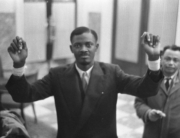This documentary begins with a 3D animated sequence set in the city of Changchun, China. In 2002, the religious group Falun Gong hijacked state-own TV channels in order to challenge the government’s negative reporting of the group, which was banned in 1999. Falun Gong, a spiritual practice that combines questions of morality with meditation and qigong-like exercises, was becoming more and more popular and, consequently, threatening to the Chinese government.
The camera weaves in and out of drab, gray buildings as those involved—or indirectly affected by the takeover—flee from the police. A few characters introduce themselves to us as they take flight, among them is Daxiong, a practitioner of Falun Gong who did not participate in the incident, and who feared that the government’s persecution would grow worse in its wake. He was then in his late twenties. The animated scene ends, and we are now with Daxiong as he is now, older with a family living in Toronto and a successful author/illustrator of comics.
First, and most simply, this film seeks to retell the story of the hijacking, to give context leading up to it and a description of the aftermath. To this end, there is narration, news excerpts, Daxiong’s interviews with expatriate Changchun residents who were involved in the seizure, and the animated re-creations of the events. Yet the film is also a reckoning, and not only with the Chinese government. Daxiong repeatedly states the anger he felt toward the hijackers: Their actions brought the police down on Falun Gong and made it unsafe for him to stay in China. In interviewing them, all now living outside of the country, Daxiong seeks to understand their perspective and set decades of anger to rest while capturing the past through animation. Based on this intention, the film fully justifies its unconventional approach.
It is a success insofar as it illuminates the lives of its subjects, the logistics of the operation and the bravery it required, and the brutality Falun Gong followers suffered at the hands of the government. The personal testimony, animation, and news clippings richly combine to make the past, and the tragedies therein, more vivid than they might otherwise have been. Hearing a description of the repression and then seeing it represented serves to portray the events and to heighten the view that what the government suppresses cannot be recovered without the aid of storytelling.
Nevertheless, when the movie comes to an end, there are questions left unexplored. As stated earlier, we watch this film with a sort of double vision, both as a source of history and as a portrait of Daxiong coming to terms with what happened. The answers it offers on the latter are, unfortunately, too easy, and some of the more probing issues the film raises are hinted at rather than spoken of.
Most importantly, Daxiong’s anger at the hijackers, which must have coexisted with his anger toward the government, is not allowed to rise to the surface, and we are left only with a trite understanding of what he must have overcome to contribute to this film. (He also created the storyboards for the animated sequences.) It is also worth noting that Falun Gong itself may be explored inadequately. There is very little testimony as to what it actually means for its practitioners, except in the most basic sense.
Like many other promising recent films, this one is more notable for the questions it raises than for what it actually conveys.







Leave A Comment